Evaluating ERA5-LAND and IMERG-NASA Products for Drought Analysis: Implications for Sustainable Water Resource Management
Abstract
1. Introduction
2. Materials and Methods
2.1. Study Area and Data Collection
2.1.1. In-Situ Meteorological Stations
2.1.2. ERA5-LAND
2.1.3. IMERG-NASA
2.2. Methodologies
2.2.1. Standardized Precipitation Index (SPI)
2.2.2. Time Period Specified by WMO and Acceptable Time Period
2.2.3. Innovative Drought Classification Matrix (IDCM)
2.2.4. Comparison Scheme
2.2.5. Drought Characteristics
- Drought duration (D) is the number of months between the starting and ending points.
- Drought severity (S) is the summation of the SPI values over drought duration.
- Drought intensity (I) is evaluated by dividing the drought severity by drought duration.
2.2.6. Spatial Interpolation Technique (IDW)
3. Results
3.1. Temporal Evaluation Using an Acceptable Time Period and the Time Recommended by WMO
3.2. Comparison SPI Results
3.3. Drought Characteristics Results and Drought Maps
3.3.1. Drought Duration
3.3.2. Drought Intensity
3.4. Drought Characteristics for a Specific Drought Event
3.4.1. Drought Duration
3.4.2. Drought Intensity
4. Discussion
4.1. Validation of the Acceptable Time Period
4.2. Performance of ERA5-LAND and IMERG-NASA Data
4.3. Drought Characteristics and High-Resolution Mapping
4.4. Importance and Implications of Satellite and Reanalysis Data in Data-Scarce Regions
4.5. Planning and Management of Water Resources with Practical Implications for Climate Change Adaptation
5. Conclusions
- The results ensure that using an acceptable and ideal time period of 10–20 years for drought studies can be sufficient and provide reliable accuracy for assessing drought with high correlation (0.99), RMSE ranged between 0.09 and 0.23 standard deviation, and IDCM ranged between 85% to 97%.
- The results confirm that while in situ data offers high accuracy at specific locations, its sparse and irregular distribution limits its use for regional-scale drought monitoring and mapping.
- The comparative analysis of drought characteristics using SPI derived from in situ, ERA5-LAND, and IMERG-NASA data reveals that satellite and reanalysis data can capture drought events and durations across different timescales.
- IMERG-NASA data gave more accurate drought results than ERA5-LAND. For example, the CC for IMERG-NASA data ranged between 0.57 and 0.89, and for ERA5-LAND, 0.22 (for one station at a 3-month timescale) and 0.89.
- The drought duration derived from in situ stations was longer compared to that obtained from ERA5-LAND and NASA data. However, the drought intensity for shorter-duration events appeared higher in ERA5-LAND and NASA datasets. This is because drought intensity is calculated as the severity divided by duration, meaning that the intensity value becomes larger when the duration is shorter.
- The resulting drought duration and intensity maps at four different timescales (1, 3, 6, and 12 months) indicate that using different data sources with different spatial and time resolution can highly affect the main results. For example, the drought duration and intensity maps differed among in situ, ERA5-LAND, and NASA-based SPI. For example, the duration of in situ-based SPI1 maps was up to 4.9 months, and for satellite and reanalysis data, it was up to 4.3 months and the intensity for SPI6, the intensity for insitu station ranged between −0.8 and −1.2, but for ERA5-LAND and IMERG-NASA, data ranged between −1.0 and −1.2.
- The drought analysis results of the ERA5-LAND data source showed that Kocaeli will face extreme drought risks much higher than the most severe drought event of recent years experienced in 2013–2014, and therefore, it is recommended that adaptation actions be implemented urgently for a resilient city, taking into account the effects of climate change.
- The proposed framework and process empower policymakers and decision-makers to effectively manage and plan water resources within the city boundaries, supporting sustainable agricultural, economic, and industrial activities, while also enhancing resilience through climate change adaptation strategies.
Author Contributions
Funding
Institutional Review Board Statement
Informed Consent Statement
Data Availability Statement
Acknowledgments
Conflicts of Interest
References
- Arra, A.A.; Alashan, S.; Şişman, E. Trends of meteorological and hydrological droughts and associated parameters using innovative approaches. J. Hydrol. 2024, 640, 131661. [Google Scholar] [CrossRef]
- Habibi, B.; Meddi, M.; Emre, T.; Boucefiane, A.; Rahmouni, A. Drought assessment and characterization using SPI, EDI and DEPI indices in northern Algeria. Nat. Hazards 2024, 120, 5201–5231. [Google Scholar] [CrossRef]
- Van Loon, A.F.; Rangecroft, S.; Coxon, G.; Werner, M.; Wanders, N.; Di Baldassarre, G.; Tijdeman, E.; Bosman, M.; Gleeson, T.; Nauditt, A.; et al. Streamflow droughts aggravated by human activities despite management. Environ. Res. Lett. 2022, 17, 044059. [Google Scholar] [CrossRef]
- Awolala, D.; Mutemi, J.; Adefisan, E.; Antwi-Agyei, P.; Taylor, A.; Muita, R.; Bosire, E.; Mutai, B.; Nkiaka, E. Economic value and latent demand for agricultural drought forecast: Emerging market for weather and climate information in Central-Southern Nigeria. Clim. Risk Manag. 2023, 39, 100478. [Google Scholar] [CrossRef]
- Waseem, M.; Jaffry, A.H.; Azam, M.; Ahmad, I.; Abbas, A.; Lee, J.E. Spatiotemporal analysis of drought and agriculture standardized residual yield series nexuses across Punjab, Pakistan. Water 2022, 14, 496. [Google Scholar] [CrossRef]
- Du, C.; Chen, J.; Nie, T.; Dai, C. Spatial–temporal changes in meteorological and agricultural droughts in Northeast China: Change patterns, response relationships and causes. Nat. Hazards 2022, 110, 155–173. [Google Scholar] [CrossRef]
- UNESCO UN-Water. United Nations World Water Development Report 2020: Water and Climate Change; UNESCO: Paris, France, 2020. [Google Scholar]
- World Economic Forum. This Is What Climate Change Costs Economies around the World. In Proceedings of the World Economic Forum, Davos, Switzerland, 16–20 January 2023; Available online: www.weforum.org (accessed on 25 March 2024).
- Sahoo, A.K.; Sheffield, J.; Pan, M.; Wood, E.F. Evaluation of the tropical rainfall measuring mission multi-satellite precipitation analysis (TMPA) for assessment of large-scale meteorological drought. Remote Sens. Environ. 2015, 159, 181–193. [Google Scholar] [CrossRef]
- Bayissa, Y.; Tadesse, T.; Demisse, G.; Shiferaw, A. Evaluation of satellite-based rainfall estimates and application to monitor meteorological drought for the Upper Blue Nile Basin, Ethiopia. Remote Sens. 2017, 9, 669. [Google Scholar] [CrossRef]
- Mishra, A.K.; Singh, V.P. A review of drought concepts. J. Hydrol. 2010, 391, 202–216. [Google Scholar] [CrossRef]
- Lu, Y.; Dai, L.; Yan, G.; Huo, Z.; Chen, W.; Lan, J.; Zhang, C.; Xu, Q.; Deng, S.; Chen, J. Effects of various land utilization types on groundwater at different temporal scales: A case study of Huocheng plain, Xinjiang, China. Front. Environ. Sci. 2023, 11, 1225916. [Google Scholar] [CrossRef]
- Abu Arra, A.; Şişman, E. New Insights into Meteorological and Hydrological Drought Modeling: A Comparative Analysis of Parametric and Non-Parametric Distributions. Atmosphere 2025, 16, 846. [Google Scholar] [CrossRef]
- McKee, T.B.; Doesken, N.J.; Kleist, J. The relationship of drought frequency and duration to time scales. In Proceedings of the 8th Conference on Applied Climatology, Anaheim, CA, USA, 17–22 January 1993; Volume 17, pp. 179–183. [Google Scholar]
- Vicente-Serrano, S.M.; Beguería, S.; López-Moreno, J.I. A multiscalar drought index sensitive to global warming: The standardized precipitation evapotranspiration index. J. Clim. 2010, 23, 1696–1718. [Google Scholar] [CrossRef]
- Mishra, A.K.; Singh, V.P. Drought modeling—A review. J. Hydrol. 2011, 403, 157–175. [Google Scholar] [CrossRef]
- Nalbantis, I.; Tsakiris, G. Assessment of hydrological drought revisited. Water Resour. Manag. 2009, 23, 881–897. [Google Scholar] [CrossRef]
- Hasan, N.A.; Dongkai, Y.; Al-Shibli, F. SPI and SPEI drought assessment and prediction using TBATS and ARIMA models, Jordan. Water 2023, 15, 3598. [Google Scholar] [CrossRef]
- Abu Arra, A.; Şişman, E. A comprehensive analysis and comparison of SPI and SPEI for spatiotemporal drought evaluation. Environ. Monit. Assess. 2024, 196, 980. [Google Scholar] [CrossRef]
- Mousavi, R.; Johnson, D.; Kroebel, R.; Byrne, J. Analysis of historical drought conditions based on SPI and SPEI at various timescales in the South Saskatchewan River Watershed, Alberta, Canada. Theor. Appl. Climatol. 2023, 153, 873–887. [Google Scholar] [CrossRef]
- Taylan, E.D. An Approach for Future Droughts in Northwest Türkiye: SPI and LSTM Methods. Sustainability 2024, 16, 6905. [Google Scholar] [CrossRef]
- Abu Arra, A.; Alashan, S.; Şişman, E. A new framework for innovative trend analysis: Integrating extreme precipitation indices, standardization, enhanced visualization, and novel classification approaches (ITA-NF). Nat. Hazards 2025, 12, 1–33. [Google Scholar] [CrossRef]
- Alsafadi, K.; Bashir, B.; Mohammed, S.; Abdo, H.G.; Mokhtar, A.; Alsalman, A.; Cao, W. Response of Ecosystem Carbon–Water Fluxes to Extreme Drought in West Asia. Remote Sens. 2024, 16, 1179. [Google Scholar] [CrossRef]
- Zhu, G.; Liu, Y.; Wang, L.; Sang, L.; Zhao, K.; Zhang, Z.; Lin, X.; Qiu, D. The isotopes of precipitation have climate change signal in arid Central Asia. Glob. Planet. Change 2023, 225, 104103. [Google Scholar] [CrossRef]
- Farhani, N.; Carreau, J.; Kassouk, Z.; Le Page, M.; Lili Chabaane, Z.; Boulet, G. Analysis of multispectral drought indices in Central Tunisia. Remote Sens. 2022, 14, 1813. [Google Scholar] [CrossRef]
- Souza, R.D.A.D.; Moura, V.; Paloschi, R.A.; Aguiar, R.G.; Webler, A.D.; Borma, L.D.S. Assessing drought response in the Southwestern Amazon forest by remote sensing and in situ measurements. Remote Sens. 2022, 14, 1733. [Google Scholar] [CrossRef]
- Houmma, I.H.; Hadri, A.; Boudhar, A.; Karaoui, I.; Oussaoui, S.; El Khalki, E.M.; Chehbouni, A.; Kinnard, C. Analysis of the Propagation Characteristics of Meteorological Drought to Hydrological Drought and Their Joint Effects on Low-Flow Drought Variability in the Oum Er Rbia Watershed, Morocco. Remote Sens. 2025, 17, 281. [Google Scholar] [CrossRef]
- Sun, Q.; Miao, C.; Duan, Q.; Ashouri, H.; Sorooshian, S.; Hsu, K.L. A Review of Global Precipitation Data Sets: Data Sources, Estimation, and Intercomparisons. Rev. Geophys. 2018, 56, 79–107. [Google Scholar] [CrossRef]
- Abu Arra, A.; Şişman, E. Innovative Drought Classification Matrix and Acceptable Time Period. for Temporal Drought Evaluation. Water Resour. Manag. 2024, 29, 2811–2833. [Google Scholar] [CrossRef]
- Wu, X.; Su, J.; Ren, W.; Lü, H.; Yuan, F. Statistical comparison and hydrological utility evaluation of ERA5-LAND and IMERG precipitation products on the Tibetan Plateau. J. Hydrol. 2023, 620, 129384. [Google Scholar] [CrossRef]
- Wałęga, A.; Cebulska, M.; Ziernicka-Wojtaszek, A.; Młocek, W.; Wałęga, A.; Nieróbca, A.; Caloiero, T. Spatial and temporal variability of meteorological droughts including atmospheric circulation in Central Europe. J. Hydrol. 2024, 642, 131857. [Google Scholar] [CrossRef]
- Liu, Z.; Xu, J.; Liu, M.; Yin, Z.; Liu, X.; Yin, L.; Zheng, W. Remote sensing and geostatistics in urban water-resource monitoring: A review. Mar. Freshw. Res. 2023, 74, 747–765. [Google Scholar] [CrossRef]
- Erhardt, R.; Di Vittorio, C.A.; Hepler, S.A.; Lowman, L.E.L.; Wei, W. Homogenized gridded dataset for drought and hydrometeorological modeling for the continental United States. Sci. Data 2024, 11, 375. [Google Scholar] [CrossRef]
- Eitzinger, J.; Daneu, V.; Kubu, G.; Thaler, S.; Trnka, M.; Schaumberger, A.; Schneider, S.; Tran, T.M.A. Grid based monitoring and forecasting system of cropping conditions and risks by agrometeorological indicators in Austria–Agricultural Risk Information System ARIS. Clim. Serv. 2024, 34, 100478. [Google Scholar] [CrossRef]
- Silva, E.H.D.L.; Silva, F.D.D.S.; Junior, R.S.D.S.; Pinto, D.D.C.; Costa, R.L.; Gomes, H.B.; Cabral, J.B., Jr.; de Freitas, I.G.F.; Herdies, D.L. Performance assessment of different precipitation databases (Gridded analyses and reanalyses) for the new Brazilian agricultural frontier: SEALBA. Water 2022, 14, 1473. [Google Scholar] [CrossRef]
- Hou, A.Y.; Kakar, R.K.; Neeck, S.; Azarbarzin, A.A.; Kummerow, C.D.; Kojima, M.; Oki, R.; Nakamura, K.; Iguchi, T. The global precipitation measurement mission. Bull. Am. Meteorol. Soc. 2014, 95, 701–722. [Google Scholar] [CrossRef]
- Joyce, R.J.; Janowiak, J.E.; Arkin, P.A.; Xie, P. CMORPH: A method that produces global precipitation estimates from passive microwave and infrared data at high spatial and temporal resolution. J. Hydrometeorol. 2004, 5, 487–503. [Google Scholar] [CrossRef]
- Funk, C.; Peterson, P.; Landsfeld, M.; Pedreros, D.; Verdin, J.; Shukla, S.; Husak, G.; Rowland, J.; Harrison, L.; Hoell, A.; et al. The climate hazards infrared precipitation with stations—A new environmental record for monitoring extremes. Sci. Data 2015, 2, 1–21. [Google Scholar] [CrossRef]
- Huffman, G.J.; Bolvin, D.T.; Braithwaite, D.; Hsu, K.; Joyce, R.; Xie, P.; Yoo, S.H. NASA global precipitation measurement (GPM) integrated multi-satellite retrievals for GPM (IMERG). Algorithm Theor. Basis Doc. (ATBD) Version 2015, 4, 30. [Google Scholar]
- Jiang, S.; Ren, L.; Xu, C.Y.; Yong, B.; Yuan, F.; Liu, Y.; Yang, X.; Zeng, X. Statistical and hydrological evaluation of the latest Integrated Multi-satellitE Retrievals for GPM (IMERG) over a midlatitude humid basin in South China. Atmos. Res. 2018, 214, 418–429. [Google Scholar] [CrossRef]
- Muñoz-Sabater, J.; Dutra, E.; Agustí-Panareda, A.; Albergel, C.; Arduini, G.; Balsamo, G.; Boussetta, S.; Choulga, M.; Harrigan, S.; Hersbach, H.; et al. ERA5-LAND: A state-of-the-art global reanalysis dataset for land applications. Earth Syst. Sci. Data 2021, 13, 4349–4383. [Google Scholar] [CrossRef]
- Steinkopf, J.; Engelbrecht, F. Verification, of ERA5 and ERA-Interim precipitation over Africa at intra-annual and interannual timescales. Atmos. Res. 2022, 280, 106427. [Google Scholar] [CrossRef]
- Xu, J.; Ma, Z.; Yan, S.; Peng, J. Do ERA5 and ERA5-LAND precipitation estimates outperform satellite-based precipitation products? A comprehensive comparison between state-of-the-art model-based and satellite-based precipitation products over mainland China. J. Hydrol. 2022, 605, 127353. [Google Scholar] [CrossRef]
- Xin, Y.; Lu, N.; Jiang, H.; Liu, Y.; Yao, L. Performance of ERA5 reanalysis precipitation products in the Guangdong-Hong Kong-Macao greater bay area, China. J. Hydrol. 2021, 602, 126791. [Google Scholar] [CrossRef]
- Tan, M.L.; Armanuos, A.M.; Ahmadianfar, I.; Demir, V.; Heddam, S.; Al-Areeq, A.M.; Abba, S.I.; Halder, B.; Kilinc, H.C.; Yaseen, Z.M. Evaluation of NASA POWER and ERA5-LAND for estimating tropical precipitation and temperature extremes. J. Hydrol. 2023, 624, 129940. [Google Scholar] [CrossRef]
- Katsanos, D.; Retalis, A.; Kalogiros, J.; Psiloglou, B.E.; Roukounakis, N.; Anagnostou, M. Performance Evaluation of Satellite Precipitation Products During Extreme Events—The Case of the Medicane Daniel in Thessaly, Greece. Remote Sens. 2024, 16, 4216. [Google Scholar] [CrossRef]
- Xin, Y.; Yang, Y.; Chen, X.; Yue, X.; Liu, Y.; Yin, C. Evaluation of IMERG and ERA5 precipitation products over the Mongolian Plateau. Sci. Rep. 2022, 12, 21776. [Google Scholar] [CrossRef]
- Yilmaz, M. Accuracy assessment of temperature trends from ERA5 and ERA5-LAND. Sci. Total Environ. 2023, 856, 159182. [Google Scholar] [CrossRef] [PubMed]
- Yuan, Y.; Liao, B. Evaluation of multi-source precipitation products for monitoring drought across China. Front. Environ. Sci. 2025, 13, 1524937. [Google Scholar] [CrossRef]
- Shangguan, W.; Zhang, R.; Li, L.; Zhang, S.; Zhang, Y.; Huang, F.; Li, J.; Liu, W. Assessment of agricultural drought based on reanalysis soil moisture in Southern China. Land 2022, 11, 502. [Google Scholar] [CrossRef]
- Zargar, M.; Bronstert, A.; Francke, T.; Zimale, F.A.; Worku, K.B.; Wiegels, R.; Lorenz, C.; Hageltom, Y.; Sawadogo, W.; Kunstmann, H. Comparison and hydrological evaluation of different precipitation data for a large tropical region: The Blue Nile Basin in Ethiopia. Front. Water 2025, 7, 1536881. [Google Scholar] [CrossRef]
- Zhang, R.; Li, L.; Zhang, Y.; Huang, F.; Li, J.; Liu, W.; Mao, T.; Xiong, Z.; Shangguan, W. Assessment of agricultural drought using soil water deficit index based on ERA5-LAND soil moisture data in four southern provinces of China. Agriculture 2021, 11, 411. [Google Scholar] [CrossRef]
- Svoboda, M.; Hayes, M.; Wood, D. Standardized Precipitation Index User Guide; World Meteorological Organization: Geneva, Switzerland, 2012. [Google Scholar]
- Huffman, G.J.; Bolvin, D.T.; Braithwaite, D.; Hsu, K.L.; Joyce, R.J.; Kidd, C.; Nelkin, E.J.; Sorooshian, S.; Stocker, E.F.; Tan, J.; et al. Integrated multi-satellite retrievals for the global precipitation measurement (GPM) mission (IMERG). Satell. Precip. Meas. 2020, 1, 343–353. [Google Scholar]
- Stephens, M.A. Use of the Kolmogorov–Smirnov, Cramer–Von Mises and related statistics without extensive tables. J. R. Stat. Soc. Ser. B Stat. Methodol. 1970, 32, 115–122. [Google Scholar] [CrossRef]
- Şen, Z.; Şişman, E. Probabilistic standardization index adjustment for standardized precipitation index (SPI). Theor. Appl. Climatol. 2024, 155, 2747–2756. [Google Scholar] [CrossRef]
- Wang, H.; Chen, Y.; Pan, Y.; Chen, Z.; Ren, Z. Assessment of candidate distributions for SPI/SPEI and sensitivity of drought to climatic variables in China. Int. J. Climatol. 2019, 39, 4392–4412. [Google Scholar] [CrossRef]
- Şen, Z.; Şişman, E.; Kızılöz, B. A new innovative method for model efficiency performance. Water Supply 2022, 22, 589–601. [Google Scholar] [CrossRef]
- Moriasi, D.N.; Arnold, J.G.; Van Liew, M.W.; Bingner, R.L.; Harmel, R.D.; Veith, T.L. Model evaluation guidelines for systematic quantification of accuracy in watershed simulations. Trans. ASABE 2007, 50, 885–900. [Google Scholar] [CrossRef]
- Yevjevich, V.M. Objective approach to definitions and investigations of continental hydrologic droughts. Doctoral Dissertation, Colorado State University, Fort Collins, CO, USA, 1967. [Google Scholar]
- Abu Arra, A.; Şişman, E. Characteristics of hydrological and meteorological drought based on intensity-duration-frequency (IDF) curves. Water 2023, 15, 3142. [Google Scholar] [CrossRef]
- Philip, G.M.; Watson, D.F. A Precise Method for Determining Contoured Surfaces. Aust. Pet. Explor. Assoc. J. 1982, 22, 205–212. [Google Scholar] [CrossRef]
- Abu Arra, A.; Şişman, E.; Birpınar, M.E. What is the best spatial interpolation technique for evaluating droughts? Intercont. Geoinf. Days 2023, 6, 278–281. [Google Scholar]
- Isinkaralar, O. Bioclimatic comfort in urban planning and modeling spatial change during 2020–2100 according to climate change scenarios in Kocaeli, Türkiye. Int. J. Environ. Sci. Technol. 2023, 20, 7775–7786. [Google Scholar] [CrossRef]
- Şan, M.; Nacar, S.; Kankal, M.; Bayram, A. Spatiotemporal analysis of transition probabilities of wet and dry days under SSPs scenarios in the semi-arid Susurluk Basin, Türkiye. Sci. Total Environ. 2024, 912, 168641. [Google Scholar] [CrossRef]
- Ramadhan, R.; Yusnaini, H.; Marzuki, M.; Muharsyah, R.; Suryanto, W.; Sholihun, S.; Vonnisa, M.; Harmadi, H.; Ningsih, A.P.; Battaglia, A.; et al. Evaluation of GPM IMERG performance using gauge data over Indonesian maritime continent at different time scales. Remote Sens. 2022, 14, 1172. [Google Scholar] [CrossRef]
- Alsumaiti, T.S.; Hussein, K.; Ghebreyesus, D.T.; Sharif, H.O. Performance of the CMORPH and GPM IMERG Products over the United Arab Emirates. Remote Sens. 2020, 12, 1426. [Google Scholar] [CrossRef]
- Gomis-Cebolla, J.; Rattayova, V.; Salazar-Galán, S.; Francés, F. Evaluation of ERA5 and ERA5-LAND reanalysis precipitation datasets over Spain (1951–2020). Atmos. Res. 2023, 284, 106606. [Google Scholar] [CrossRef]
- Abu Arra, A.; Birpınar, M.E.; Gazioğlu, Ş.A.; Şişman, E. Critical drought characteristics: A new concept based on dynamic time period scenarios. Atmosphere 2024, 15, 768. [Google Scholar] [CrossRef]
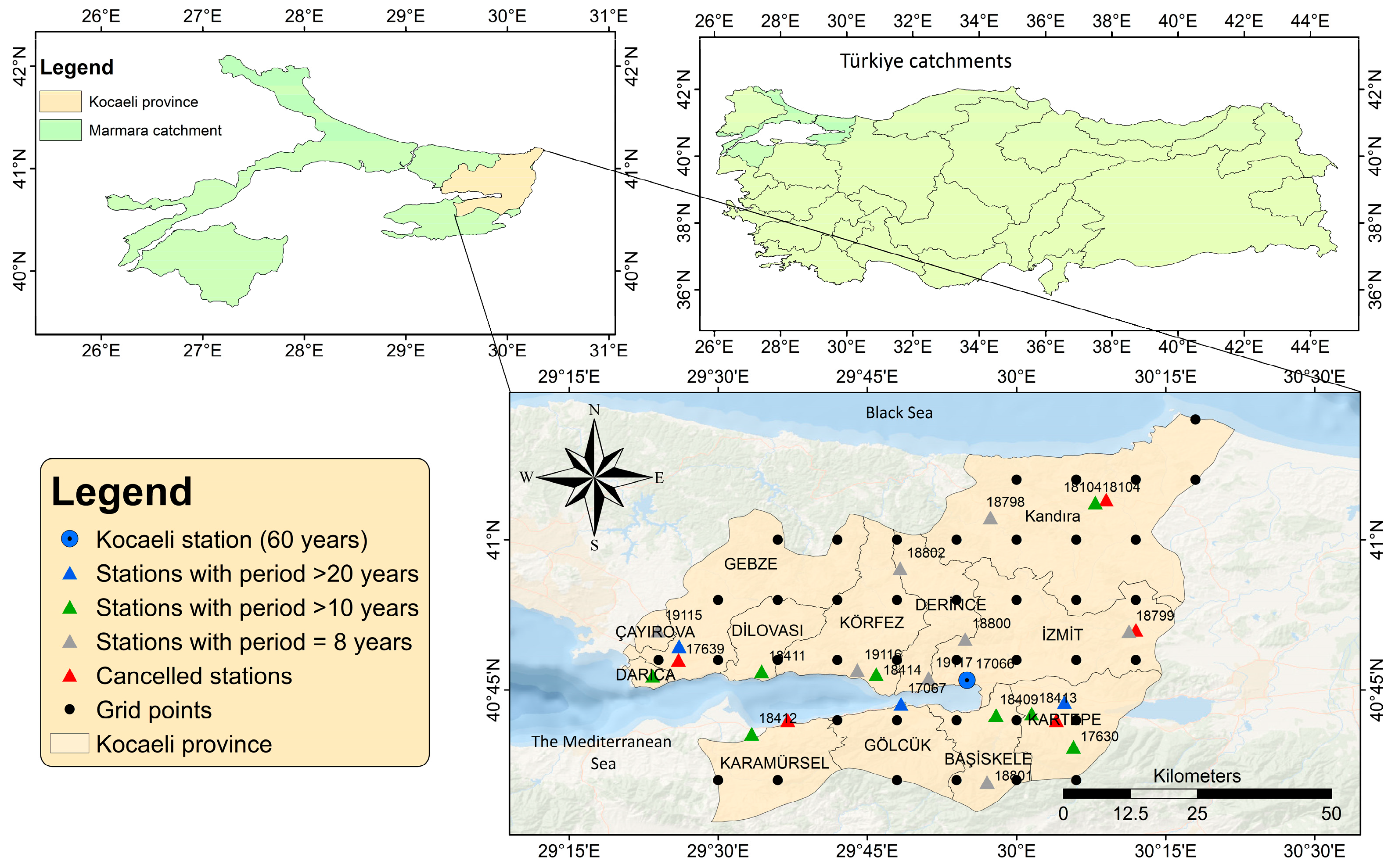

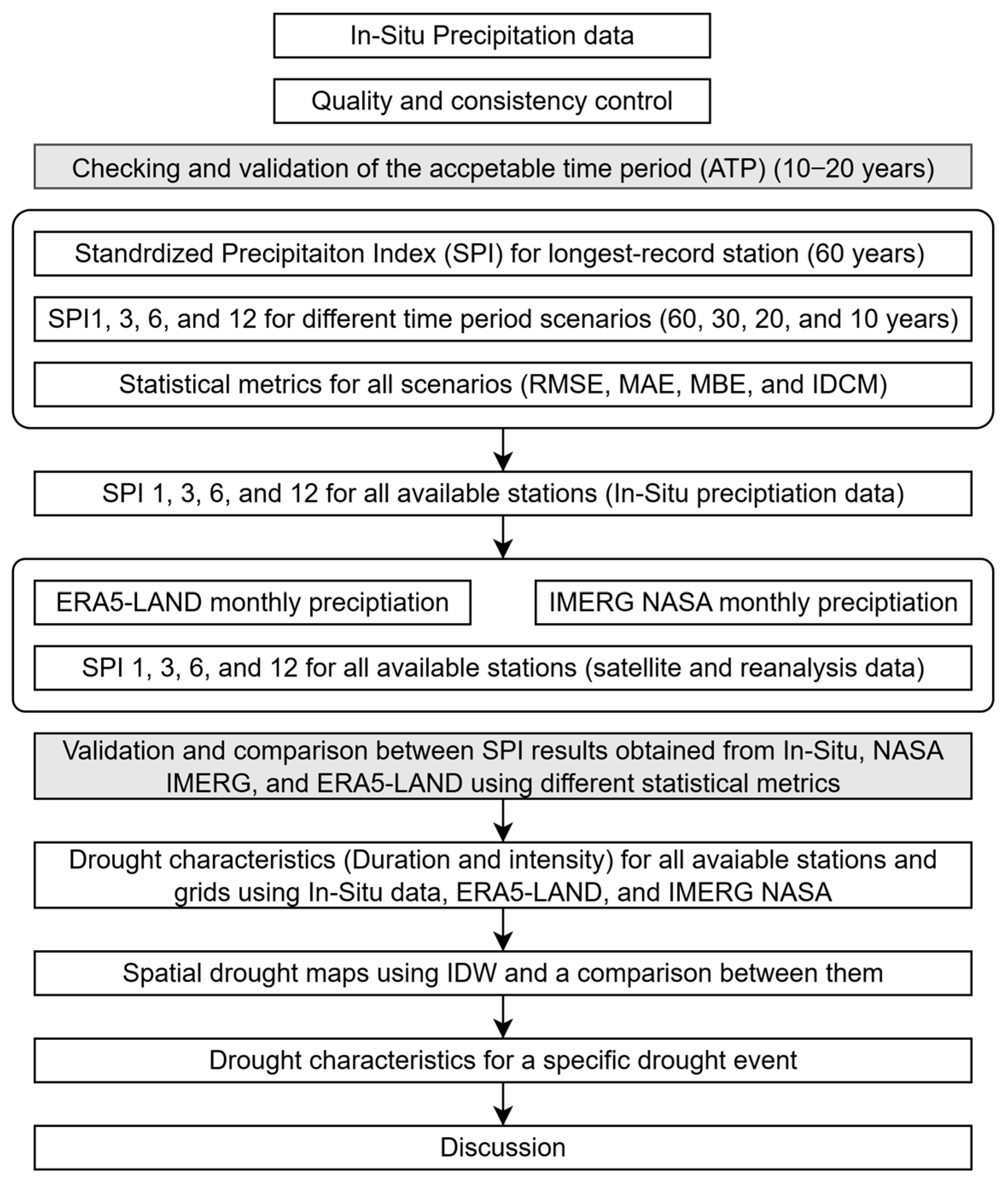
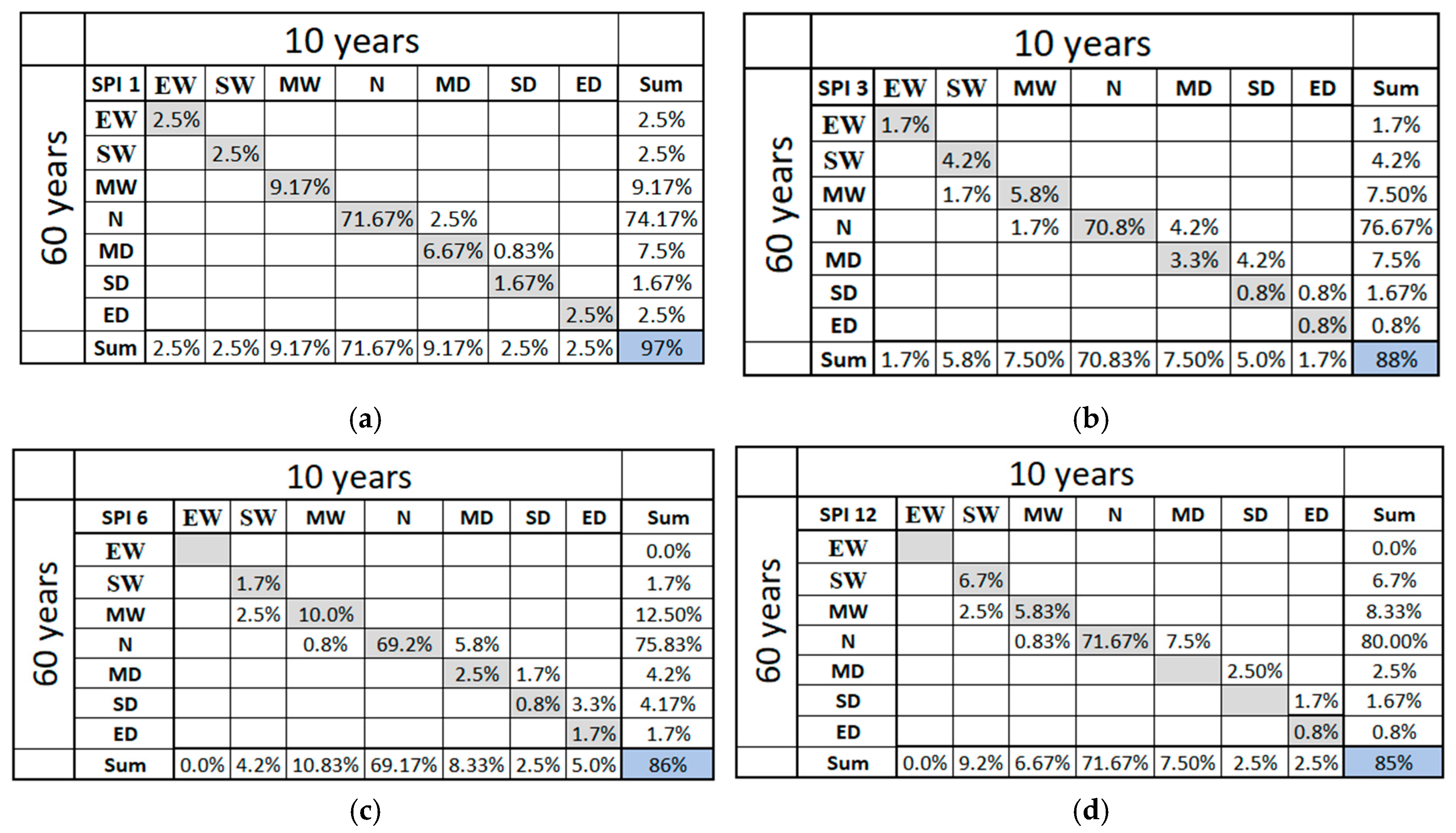
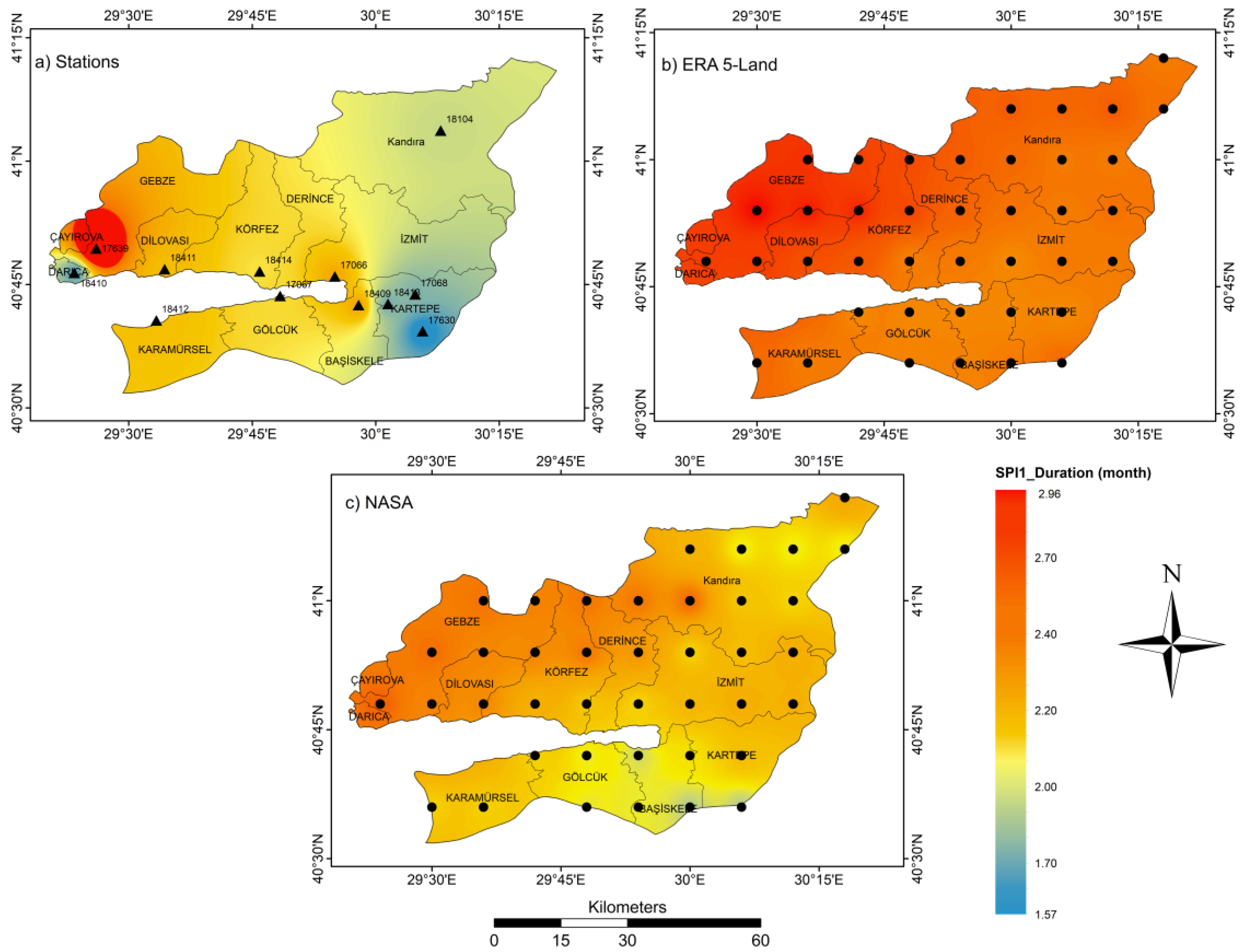
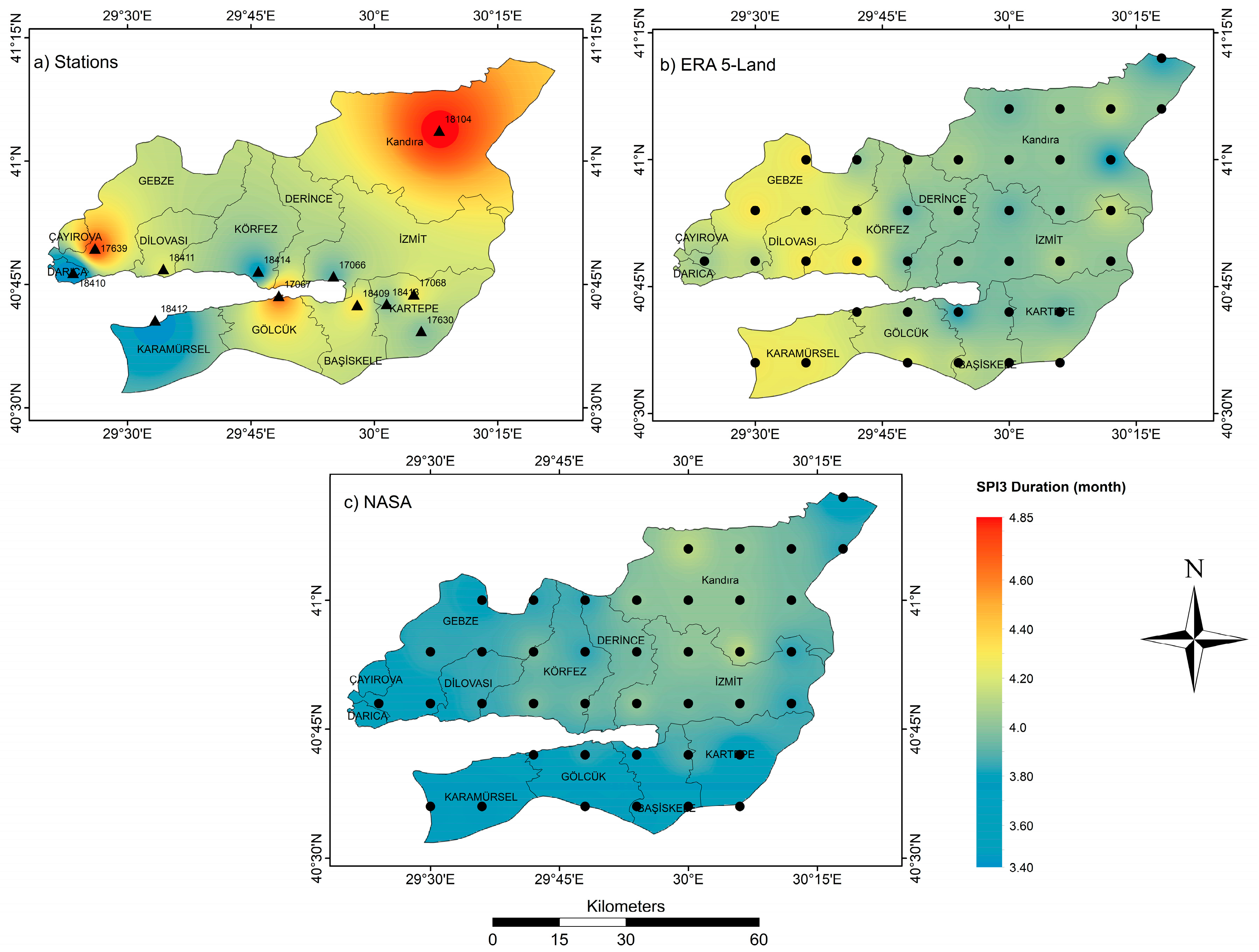
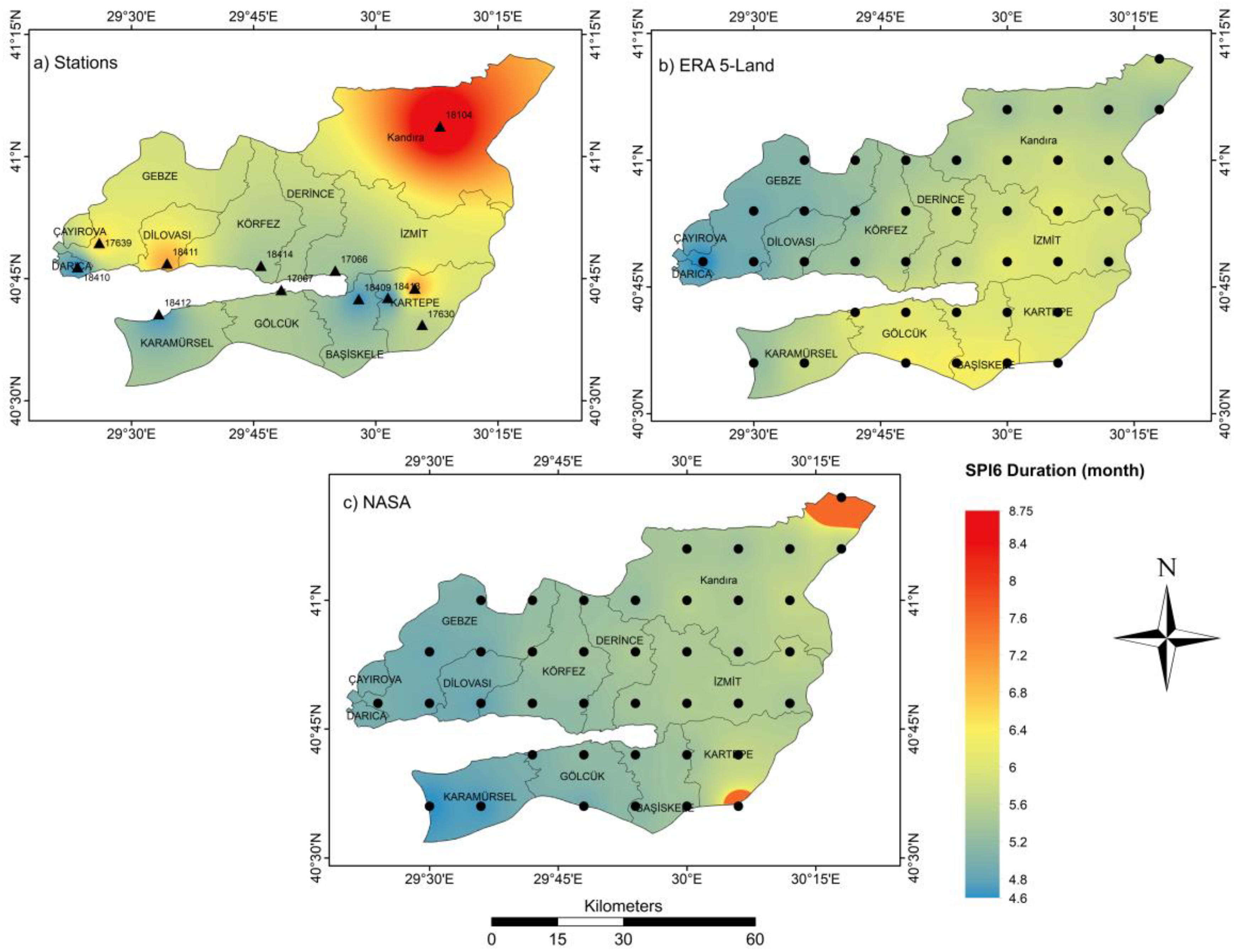
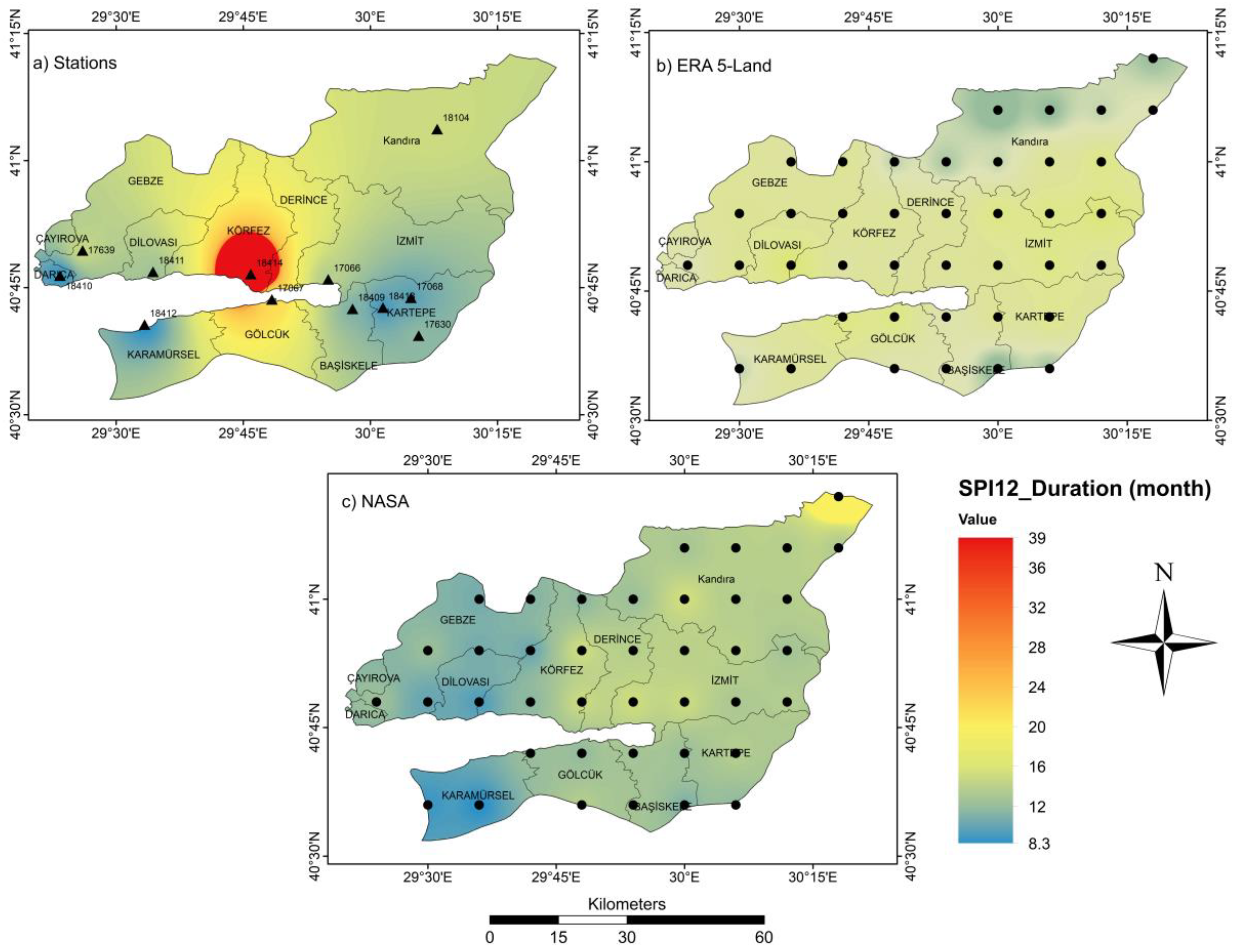
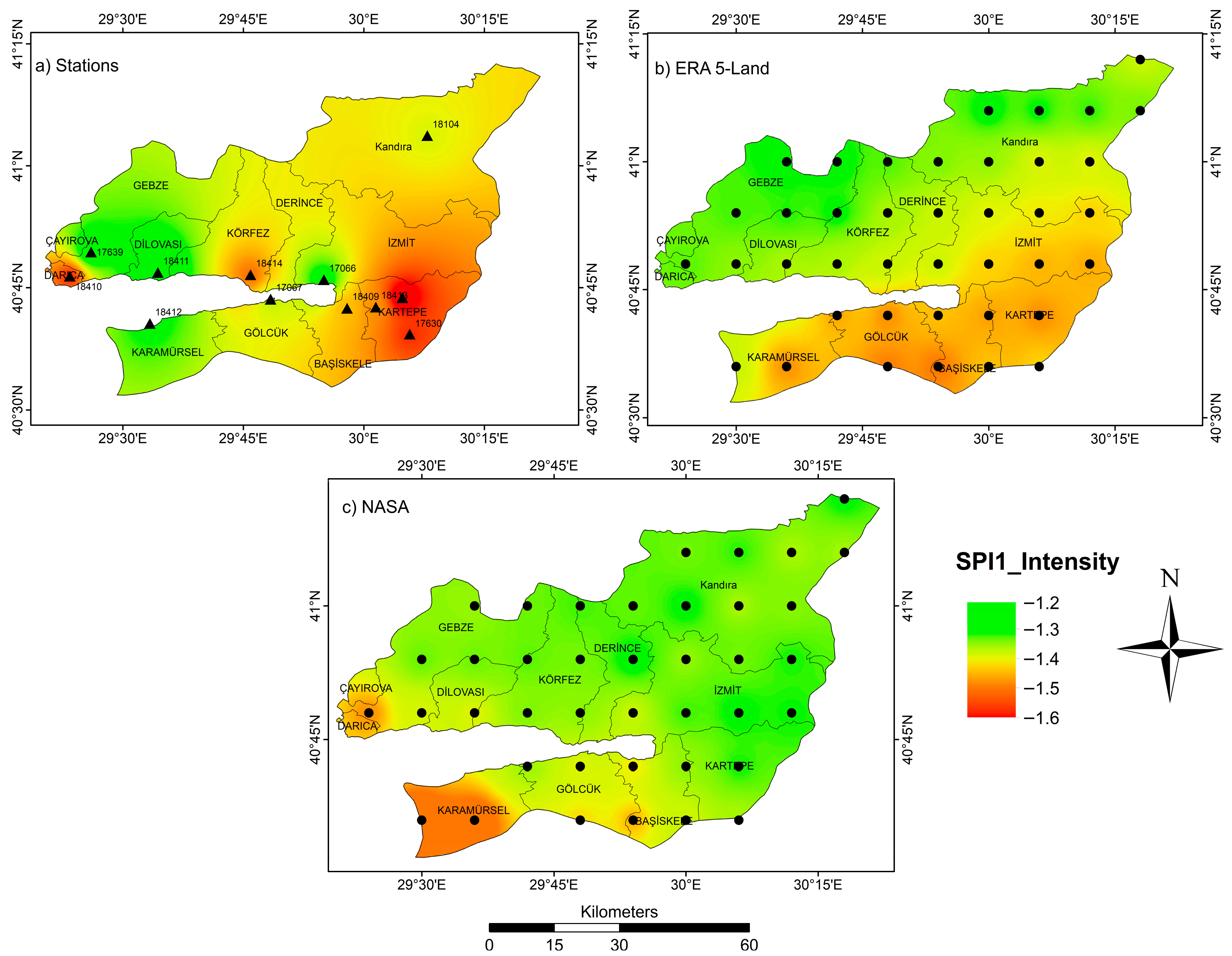

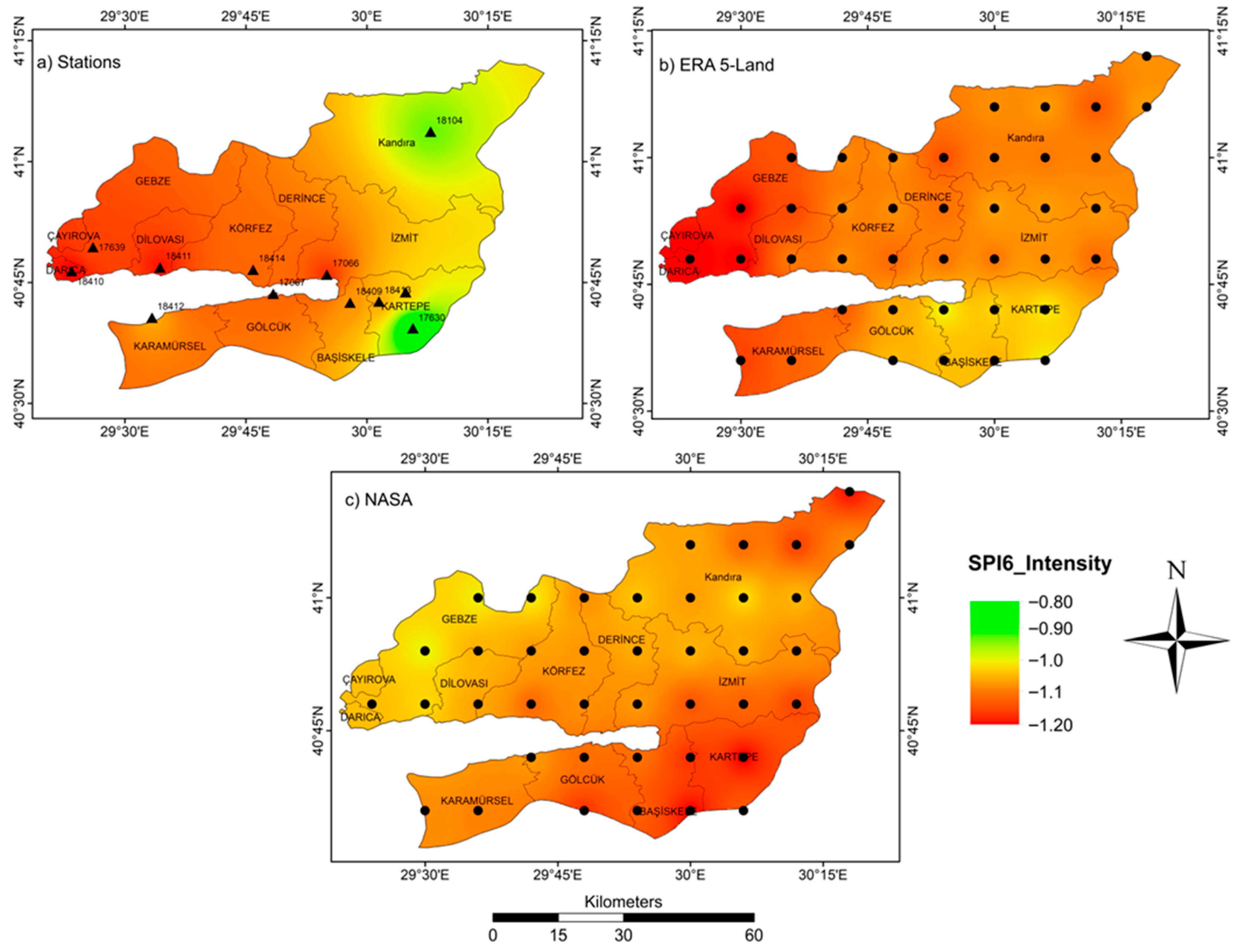
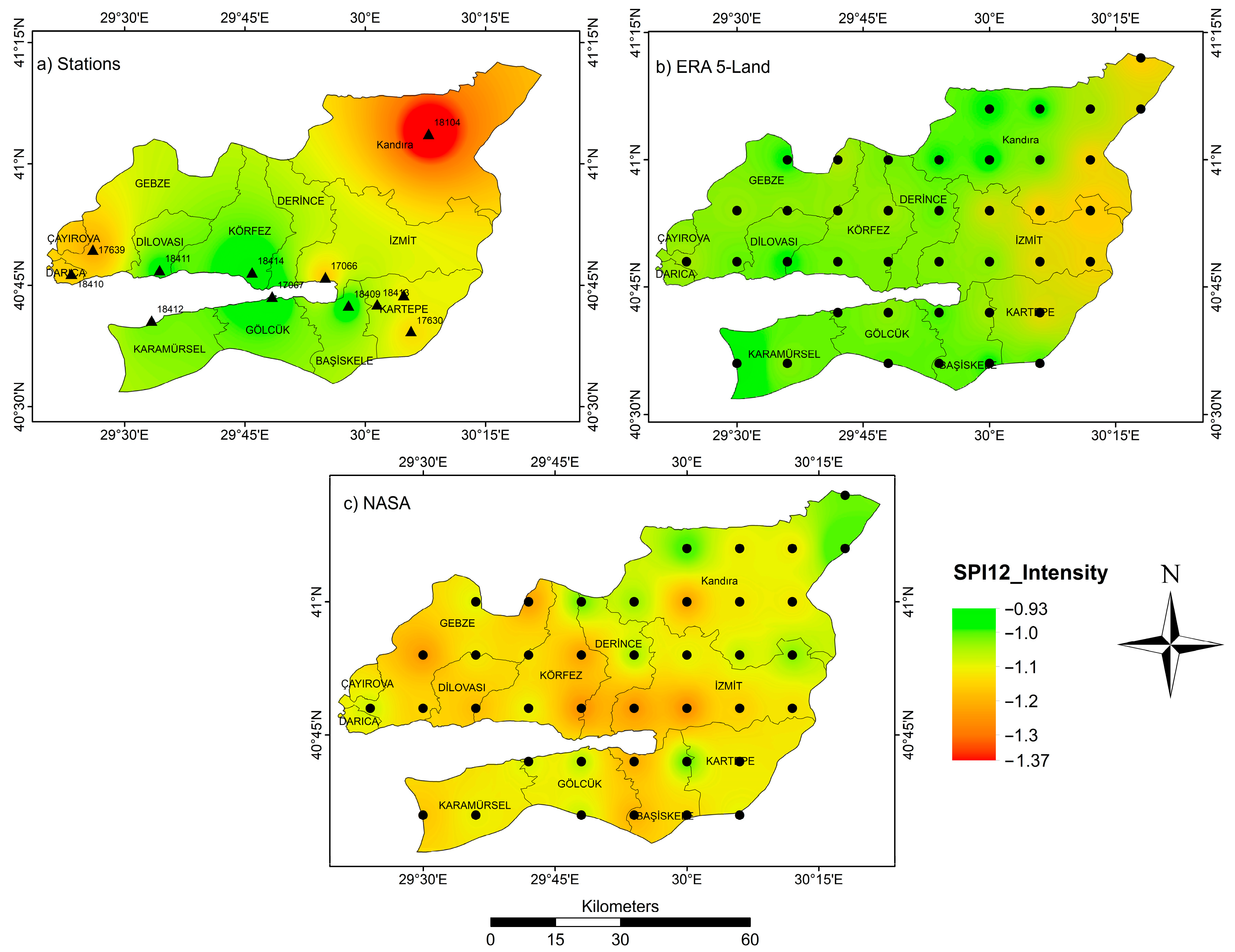
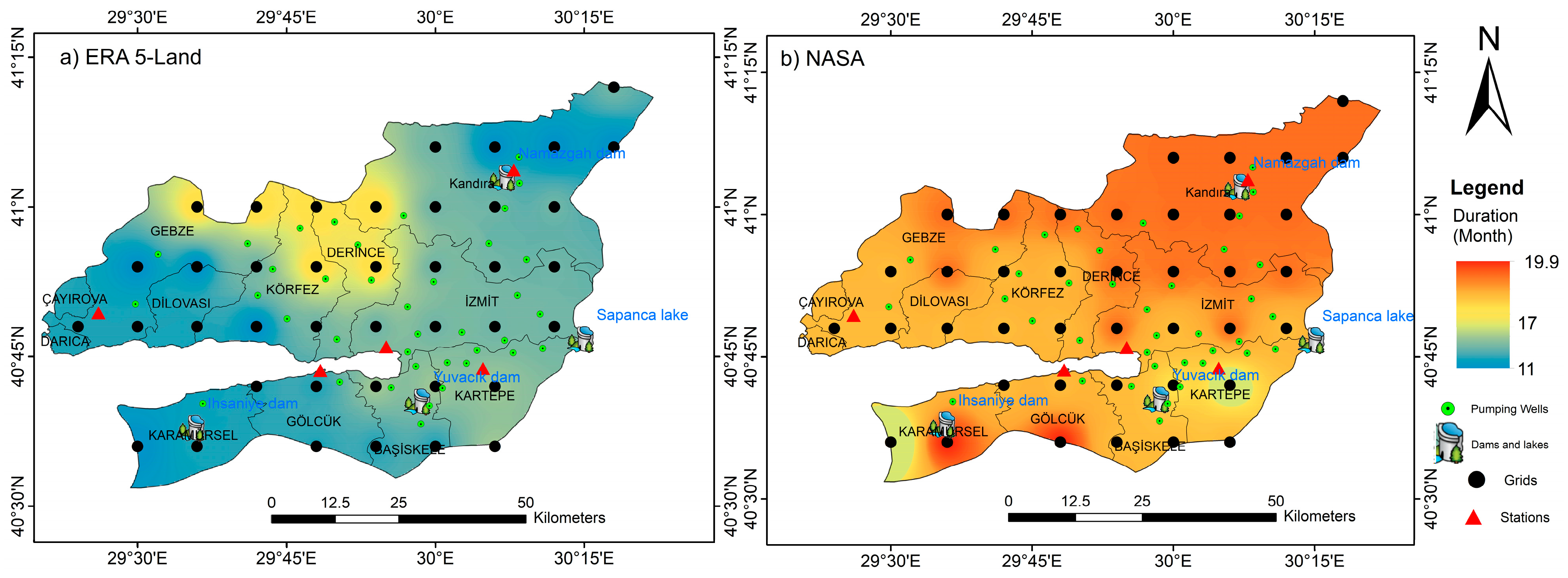

| Drought Index_DI (SPI) | Drought Classification | Probability (%) |
|---|---|---|
| 2.00 ≤ DI | Extreme wet (EW) | 2.31% |
| 1.50 ≤ DI < 2.00 | Severe wet (SW) | 4.42% |
| 1.00 ≤ DI < 1.50 | Moderate wet (MW) | 9.22% |
| −1.00 ≤ DI < 1.00 | Normal (N) | 68.1% |
| −1.50 ≤ DI < −1.00 | Moderate drought (MD) | 9.22% |
| −2.00 ≤ DI < −1.50 | Severe drought (SD) | 4.42% |
| −2.00 > DI | Extreme drought (ED) | 2.31% |
| Time Period | Years |
|---|---|
| Ideal time period | 20–30 years |
| Optimal time period | 50–60 years |
| Acceptable time period | 10–20 years |
| Statistic Metric | Equation | Value Range | Ideal Value |
|---|---|---|---|
| Correlation Coefficient (CC) | (−1)–(1) | 1 | |
| Coefficient of determination (R2) | (0)–(1) | 1 | |
| Root Mean Square Error (RMSE) | (0)–(∞) | 0 | |
| Mean Absolute Error (MAE) | (0)–(∞) | 0 | |
| Mean Bias Error (MBE) | (−∞)–(∞) | 0 |
| 60-30/60-20/60-10 | SPI1 | SPI3 | SPI6 | SPI12 |
|---|---|---|---|---|
| RMSE | 0.07/0.09/0.14 | 0.11/0.11/0.15 | 0.12/0.08/0.16 | 0.21/0.14/0.23 |
| MAE | 0.06/0.07/0.09 | 0.09/0.09/0.12 | 0.11/0.07/0.12 | 0.21/0.14/0.18 |
| MBE | −0.06/−0.06/−0.08 | −0.09/−0.07/−0.07 | −0.11/−0.07/−0.07 | −0.21/−0.14/−0.15 |
| IDCM | 95%/95%/97% | 93%/89%/88% | 91%/95%/86% | 85%/87%/85% |
| IMERG-NASA | ERA5-LAND | |||||||
|---|---|---|---|---|---|---|---|---|
| SPI1 | 17067 | 17639 | 17068 | 17066 | 17067 | 17639 | 17068 | 17066 |
| CC | 0.82 | 0.55 | 0.84 | 0.86 | 0.73 | 0.74 | 0.79 | 0.86 |
| R2 | 0.67 | 0.31 | 0.70 | 0.75 | 0.53 | 0.55 | 0.63 | 0.74 |
| RMSE | 0.59 | 0.91 | 0.57 | 0.52 | 0.73 | 0.71 | 0.68 | 1.35 |
| MBE | −0.03 | −0.04 | −0.02 | −0.07 | −0.09 | −0.14 | −0.09 | −0.06 |
| MAE | 0.41 | 0.51 | 0.73 | 0.36 | 1.10 | 1.07 | 1.10 | 0.47 |
| SPI3 | ||||||||
| CC | 0.82 | 0.60 | 0.83 | 0.87 | 0.22 | 0.81 | 0.78 | 0.87 |
| R2 | 0.68 | 0.36 | 0.69 | 0.76 | 0.05 | 0.65 | 0.61 | 0.76 |
| RMSE | 1.89 | 1.77 | 1.87 | 1.86 | 1.85 | 1.93 | 1.86 | 1.86 |
| MBE | −0.03 | −0.03 | −0.03 | −0.09 | −0.09 | −0.13 | −0.12 | −0.08 |
| MAE | 0.43 | 0.52 | 0.72 | 0.35 | 1.05 | 1.04 | 1.10 | 0.42 |
| SPI6 | ||||||||
| CC | 0.83 | 0.56 | 0.82 | 0.89 | 0.64 | 0.82 | 0.78 | 0.89 |
| R2 | 0.68 | 0.31 | 0.68 | 0.79 | 0.41 | 0.68 | 0.62 | 0.79 |
| RMSE | 0.59 | 0.94 | 0.59 | 0.47 | 0.88 | 0.62 | 0.74 | 0.47 |
| MBE | −0.04 | −0.03 | −0.04 | −0.12 | −0.11 | −0.17 | −0.14 | −0.10 |
| MAE | 0.45 | 0.54 | 0.77 | 0.34 | 1.01 | 1.00 | 1.06 | 0.41 |
| SPI12 | ||||||||
| CC | 0.75 | 0.35 | 0.74 | 0.87 | 0.61 | 0.75 | 0.77 | 0.87 |
| R2 | 0.57 | 0.12 | 0.54 | 0.76 | 0.37 | 0.56 | 0.59 | 0.76 |
| RMSE | 0.72 | 1.19 | 0.74 | 0.53 | 1.17 | 1.36 | 1.23 | 0.53 |
| MBE | −0.01 | −0.02 | −0.04 | −0.18 | −0.07 | −0.18 | −0.20 | −0.15 |
| MAE | 0.58 | 0.64 | 1.04 | 0.38 | 0.84 | 0.98 | 1.01 | 0.39 |
Disclaimer/Publisher’s Note: The statements, opinions and data contained in all publications are solely those of the individual author(s) and contributor(s) and not of MDPI and/or the editor(s). MDPI and/or the editor(s) disclaim responsibility for any injury to people or property resulting from any ideas, methods, instructions or products referred to in the content. |
© 2025 by the authors. Licensee MDPI, Basel, Switzerland. This article is an open access article distributed under the terms and conditions of the Creative Commons Attribution (CC BY) license (https://creativecommons.org/licenses/by/4.0/).
Share and Cite
Abu Arra, A.; Birpınar, M.E.; Şişman, E. Evaluating ERA5-LAND and IMERG-NASA Products for Drought Analysis: Implications for Sustainable Water Resource Management. Sustainability 2025, 17, 7529. https://doi.org/10.3390/su17167529
Abu Arra A, Birpınar ME, Şişman E. Evaluating ERA5-LAND and IMERG-NASA Products for Drought Analysis: Implications for Sustainable Water Resource Management. Sustainability. 2025; 17(16):7529. https://doi.org/10.3390/su17167529
Chicago/Turabian StyleAbu Arra, Ahmad, Mehmet Emin Birpınar, and Eyüp Şişman. 2025. "Evaluating ERA5-LAND and IMERG-NASA Products for Drought Analysis: Implications for Sustainable Water Resource Management" Sustainability 17, no. 16: 7529. https://doi.org/10.3390/su17167529
APA StyleAbu Arra, A., Birpınar, M. E., & Şişman, E. (2025). Evaluating ERA5-LAND and IMERG-NASA Products for Drought Analysis: Implications for Sustainable Water Resource Management. Sustainability, 17(16), 7529. https://doi.org/10.3390/su17167529








